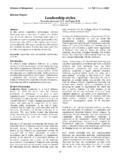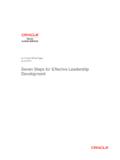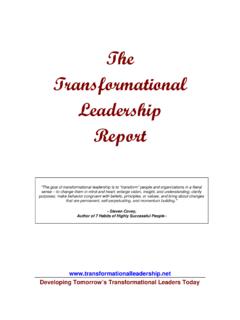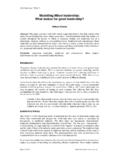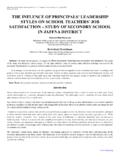Transcription of The Use of the Multifactor Leadership …
1 International Journal of Scientific and Research Publications, Volume 2, Issue 11, November 2012 1 ISSN 2250-3153 The Use of the Multifactor Leadership questionnaire and Communication Satisfaction questionnaire in Palestine: A Research Note Alaedin Khalil Alsayed*, Mohammad Hossein Motaghi**, Intan Binti Osman** * School of Management, Universiti Sains Malaysia ** Graduate School of Business, Universiti Sains Malaysia ** Woman s Development Research Centre (KANITA), Universiti Sains Malaysia Abstract- This research note presents the results of testing the goodness (factor analysis and reliability) of two questionnaires communication satisfaction and Leadership style within the Palestinian community.
2 The paper further discusses dimensionality for each construct. The Multifactor Leadership questionnaire (MLQ) [1] rates Leadership behaviors utilized by leaders/supervisors. The MLQ has been widely tested for its reliability in diverse context. Communication Satisfaction questionnaire (CSQ) [2] measures the level of individuals satisfaction with organizational communication in several organizations. Palestine, with its uniqueness, provides an ideal context to test both of these scales to be serviced in similar communities. The present study has adapted the original MLQ and CSQ to fit with the Arabian culture.
3 Both scales were translated into Arabic language, back translated, and reviewed by specialists. Both scales performed well and provide strong support for the validity and reliability of each scale, allowing other researchers a high degree of confidence in their application. The finding suggests that these research tools may be useful and can be expanded to the greater Arabian region Index Terms- Multifactor Leadership questionnaire (MLQ), Communication satisfaction questionnaire (CSQ), Dimensionality. I. INTRODUCTION rganizational development is an important issue that was considered by literature.
4 Two constructs in this stream of research are; transformational transactional Leadership [3], and communication satisfaction [2]. These constructs are proved as important issues to ensure organizational development, success, and effectiveness. This brief research note presents evidence of these two terms application and goodness in Palestine. The present study believes that this research note is necessary because of the dearth of applied business research particularly in Palestine and Middle East more generally. Additionally, it would be suggested that the present study is the first to investigate Leadership styles and communication satisfaction specifically in public sector of Palestine, and their evaluation from employees perspective.
5 Leadership style is defined as interpersonal influence, directed through communication toward goal attainment. [4]. It is also defined as "the process of influencing leaders and followers to achieve organizational objectives through change"[5]. To ensure a holistic understanding for this concept, Leadership is further defined as "the ability to influence a group towards the achievement of goals" [6]. Among the previous definitions, it would be concluded that, Leadership is the ability of interpersonal influence to direct followers through communication, and to achieve through change the organizational objectives.
6 The reflection of these definitions in light of contemporary theories of Leadership emerged three styles that are; transformational, transactional, and laissez-faire. The transformational Leadership theory fist appeared in 1978, when Burns made the attempt to study political Leadership ; as such it was derived from political science [7], and developed later by Bass [3].The present believes that transformational Leadership is a key of change, through its factors of influence (idealized influence, intellectual stimulation, inspirational motivation and individual consideration).
7 Transformational Leadership refers to a process focusing on the exchange between leaders and followers by motivating followers' attitudes, it is the process of building employee loyalty to meet the organizational visions, missions, strategies and objectives by the leaders [8], not only because it is detrimental to the behavior of leaders and greatly affect on individuals performance, but also because it built on creative exchange between the leader and followers to meet organizational vision through a change in values [3]. The second style refers to transactional Leadership that is very necessary to ensure the managerial role of the leader.
8 It connotes a communal process of exchange between leaders and followers in order to persuade the followers to meet up their assigned duties so that the followers can claimed the benefits such as pay, rewards, advancement or recognition from the organizations [9, 10]. Transactional Leadership could be observed through two factors that are; contingent reward and management-by-exception that would be active or passive. Both styles of Leadership combine between the ability of influence and crating internal emotions toward the goals and the best way how successfully the objectives could be achieved.
9 It is somehow combining between charisma of personality (transformational) and resolution reaction (transactional) dealing with organizations. Indeed, transformational and transactional styles to be effectively utilized the role of effective communication should be ensured. The third style of Leadership reflects the absence of these two styles that called laissez-faire, it refers to passive/avoidant or no Leadership . In other word, when the leader O International Journal of Scientific and Research Publications, Volume 2, Issue 11, November 2012 2 ISSN 2250-3153 avoid to take decision, has negative influence on followers, delay to deal with problems, thus, his style is laissez-faire.
10 Reviewing the literature, Leadership styles were found to be significantly related to several organizational factors where, transformational style registered positive impact, transactional style had uncertain effect. Further information about uncertain findings of transactional style is provided later in this paper. Laissez-faire style on the other hand, was related significantly and negatively with; motivation [11], extra effort and effectiveness [12, 13], creativity and work attitude [14], and job performance [15]. Authors introduced the Multifactor Leadership questionnaire (MLQ) to measure this term[1].










